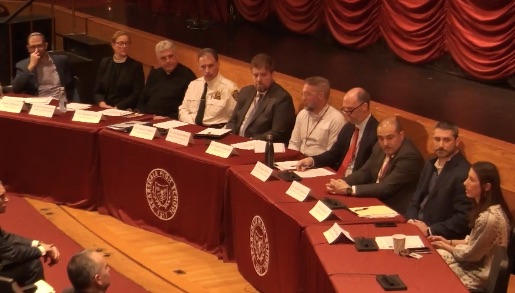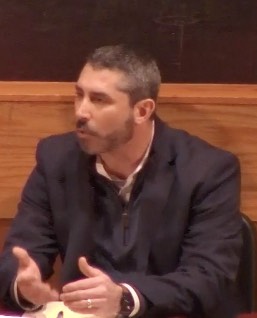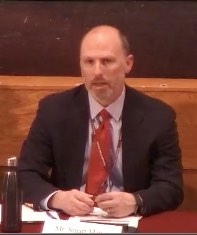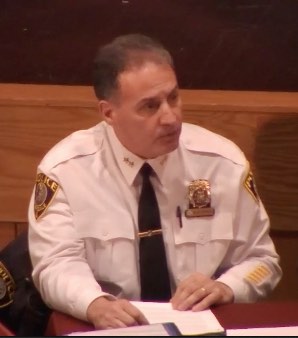Safety and Security Panel Stresses Prevention; Not Reaction
- Tuesday, 29 January 2019 13:38
- Last Updated: Tuesday, 29 January 2019 13:59
- Published: Tuesday, 29 January 2019 13:38
- Laura Halligan
- Hits: 5192
 If you were looking for a debate on guns, metal detectors or other security issues, you may have been disappointed after last week’s safety and security forum. What attendees did get, however, was reassurance that Scarsdale officials are thinking about school safety and a case for preventing violence instead of reacting to it.
If you were looking for a debate on guns, metal detectors or other security issues, you may have been disappointed after last week’s safety and security forum. What attendees did get, however, was reassurance that Scarsdale officials are thinking about school safety and a case for preventing violence instead of reacting to it.
A joint presentation by the Scarsdale government and school district, the forum featured a number of representatives from Scarsdale schools and Scarsdale-Edgemont Family Counseling Service (SFCS), as well as the chief of police and a few clergy members.
Scarsdale Mayor Dan Hochvert got things started by stating, “The panel will cover just about all the major aspects of Scarsdale that we are concerned about, and we hope… you will be resting more easily about safety and security.” He then stated that the panelists would not provide details on security measures, but invited attendees to write down any questions they wanted answered that evening. This put limits on time and content, but did offer residents some opportunity to be heard.
Scarsdale Schools Superintendent Thomas Hagerman followed and said, “We really want to demonstrate to the Scarsdale community that all of us… are really standing shoulder-to-shoulder around safety, security and emergency management practices… ” He then echoed Hochvert’s comments about the nature of the discussion, “You don’t always have multi agencies coming together around a common topic… so, the kinds of questions we’re looking for are questions that can be answered by anyone on the panel.”
First Line of Defense: Promoting Mental Health
Despite the fact that schools remain as one of the safest places for children, the epidemic in school violence certainly weighs on all our minds. And, although Scarsdale is a relatively safe community, many residents are concerned about protecting our children in worst-case scenarios. But, as residents heard last week, security is part of the issue. To assure safety, experts contend we must address the underlying causes of antisocial and potentially dangerous behavior.
 Jay Genova, Executive Director of SFCS, explained that his organization provides critical prevention and intervention services to individuals and families, both in and out of Scarsdale schools. Probably best known via the Scarsdale Community Youth Services Project, SFCS works directly with the district via its team of mental health professionals in the middle and high school. These counselors provide “on the ground” crisis intervention, outreach services, and supportive counseling to individuals and their families.
Jay Genova, Executive Director of SFCS, explained that his organization provides critical prevention and intervention services to individuals and families, both in and out of Scarsdale schools. Probably best known via the Scarsdale Community Youth Services Project, SFCS works directly with the district via its team of mental health professionals in the middle and high school. These counselors provide “on the ground” crisis intervention, outreach services, and supportive counseling to individuals and their families.
Genova said, “Not everybody who feels isolated or disenfranchised is going to be a perpetrator of violence. However, many who do perpetrate violence often feel disconnected or disenfranchised… (We) give them an outlet… to express what they might be feeling and to regain some sense of hope… What’s important to us is to make sure that people feel acknowledged, they feel validated, that they feel heard.” He continued, “We want to give people the opportunity to be heard before they have to rely on their behaviors or on any type of extreme situation…”
Lauren Pomerantz, one of SFCS’ youth outreach workers and coordinator of The Safe Coalition, expanded on Genova’s points and discussed the root causes and risk factors of many types of violent behavior – cultural norms that support aggression; harmful norms about masculinity and femininity; social isolation and lack of social support; a history of violent victimization or witnessing violence; and poor parent-child relationships and conflict.
“We feel like these are really relevant and important to talk about, and, if we’re talking about them as root causes or risk factors, we can also turn it around and talk about all of the protective factors that exist. One… is, obviously, the collaboration and coordination of resources like we see tonight; access to mental health (services); family connections and connection to the community.”
The audience then heard from Assistant Superintendent for Business and Facilities Stuart Mattey , who began  by reiterating the school district’s commitment to safety and security. “This commitment takes many forms and has evolved over the years as security-related norms have changed. However, the focus of the district’s efforts is generally concentrated not only on plant upgrades and security-related practices, (but) most importantly, the social and emotional well-being of our students.“
by reiterating the school district’s commitment to safety and security. “This commitment takes many forms and has evolved over the years as security-related norms have changed. However, the focus of the district’s efforts is generally concentrated not only on plant upgrades and security-related practices, (but) most importantly, the social and emotional well-being of our students.“
He then mentioned the ability of staff members, along with assistance from community partners such as SFCS and the police department, to support students through a wide range of social/emotional issues, such as peer conflicts, difficult family situations, stress, and challenges in decision-making.
Mattey also discussed current proposals to augment existing security measures and the district’s work with an independent security consultant. “Alteris (Emergency Management Group) has assisted the district in gaining congruence in all buildings in three critical areas: 1) preparedness and prevention; 2) emergency response; and 3) post-incident recovery procedures… To have a ‘go-to’ security professional onsite, the district hired… Mike Spedaliere as its Chief of Safety, Security and Emergency Management this past summer.” He added that, in concert with the Scarsdale Police Department, teachers and students receive ongoing emergency training through various drills that are continually assessed for improvement.
 Next to speak was Scarsdale Chief of Police Andrew Matturro, who described his department’s “continued response and efforts to address the active shooter threat in society today.” Scarsdale police officers have, for years, received training in the latest rapid response techniques; and, for almost two decades, the department has utilized a formal rapid deployment and response program to ensure every member of the force is able immediately respond to any emergency in schools (and other locations throughout the village).
Next to speak was Scarsdale Chief of Police Andrew Matturro, who described his department’s “continued response and efforts to address the active shooter threat in society today.” Scarsdale police officers have, for years, received training in the latest rapid response techniques; and, for almost two decades, the department has utilized a formal rapid deployment and response program to ensure every member of the force is able immediately respond to any emergency in schools (and other locations throughout the village).
In discussing the Police Department’s work with the district, Matturro explained, “Personnel serve on our department’s school safety tactical response committee… (And,) over six years ago, in cooperation with the district, our department instituted a random school walkthrough program, where officers are assigned to randomly visit and conduct walkthroughs of our (public) senior high school, middle school and elementary schools. This has been expanded to include other schools within our village and houses of worship that wish to participate. Members of our department (also) participate in meetings of the district-wide safety team, and regularly participate in school exercises and drills.”
The Reverend Dr. Kelley Hough Rogers, senior minister at Scarsdale Congregational Church, was the last panel member to speak, and expressed support for various community organizations’ efforts to assure safety. In discussing specific measures at each house of worship, she added, “We invite dialogue… We are going to be more aware of our spot in the community and how we can be better prepared for any type of emergency that may befall us. I think we’re all in agreement that we really feel it is critical to protect people in their most sacred hours and we’re committed to doing so.”
Q’s and A’s in Brief
PT Council President Amber Yusef then read a variety of questions posed by audience members, ranging from the timing of the installation of security vestibules, to addressing students’ special needs during emergencies, to the district’s choice of Altaris as its security consultant. But the questions discussed in greatest detail were whether there should be an armed presence in our schools and how to address the root causes of violence.
To Arm or Not to Arm?
First, the panel was asked if armed security officers were a viable option for improving school security, if there is data showing armed guards make schools safer, and whether armed guards would make a difference if police response was delayed.
Hagerman began by explaining that armed police officers or SROs were present at many of the schools, including Marjory Stoneman Douglas, where recent shootings have taken place. “In some cases, it helped to mitigate or shorten the length of time of those tragedies, but we also know there were victims.”
He went on, “You can look back at a number of school shootings and look at the efficacy of… having armed guards. For us, it’s more of a philosophical question… We’ve heard from some… in our community who feel very comfortable having armed guards or armed personnel at our schools, and there is another group, who feel just as strongly… do not want to have their children in environments with armed guards.”
Mattey stated that SROs were among a long list of possible security measures, but were not likely to be put into place over the short-term. “It’s a long discussion for the community and the schools, and that conversation will continue over the next year.”
Director of Special Education and Student Services Eric Rauschenbach then discussed the difference between armed security guards and SROs. “The main purpose of (an SRO) is not to be a security monitor… It is an actual teaching and interaction-with-student position that allows for close connections between the police department and community. “
He added that, unlike armed guards, who are civilians who may or may not have police training, SROs are specially trained police officers who are placed in schools typically in communities that need improved relationships between the public and law enforcement. This, along with the fact that Scarsdale Police already have a presence in the schools, makes SROs less of a fit for Scarsdale.
In addressing police response time in a potential school emergency, Matturro volunteered that his department’s average response time was 4m, 40s on all calls and 4m, 5s on priority calls, with response time on emergencies “much quicker.” He also noted that, at times, an officer in a squad car is be able to respond more quickly than an armed guard on foot. Matturro also reiterated the importance of focusing on preventing violence in the first place by coordinating local services.
The panel then was asked how the community could weigh in on the question of armed guards in the schools. Mattey replied, “The BOE is always receptive to information provided… certainly at board of education meetings – we have a public comment period – and, of course, emails are very powerful (in making) your concerns known. Evenings such as this are other great opportunities...” He went on, “For some of these bigger issues that might need a longer conversation, that might change… how we might think about our buildings, maybe another forum might be appropriate.“
Inclusiveness vs. Isolation
The next question was about the best ways to address the root causes of violence and work with at-risk children and young adults.
Genova responded, “No matter how many counselors you can hire, you are always going to look to the community to be a part of this. Root causes have a lot to do with the cultural and existing conditions that lead people toward violence.”
He continued, “For instance, we want to protect our children. We may see children who our children are associated with, and we may not like their behaviors. We will, more than likely, tell our children, ‘Let’s stay away from that child.’ How does that impact community safety? …Are we making that child more isolated? Are we depriving that child of some valuable, positive connections that they can learn from? If we’re not reaching out to that child – and, I’m not saying this is easy – we are creating some of the circumstances that lead people toward violent behavior.”
Genova then said creating a safe community means creating a better-connected community that includes individuals who “don’t look like us, sound like us, believe in our beliefs, or behave in ways we approve of.”
Rauschenbach concurred with Genova and added, “When we look at students with mental health challenges in the schools, we have… a community that is cognizant of each other, and unafraid to come to school (officials) and report something that they find difficult or disturbing… At the same time, (we) understand that, whenever a child or group of children are making decisions that we find disturbing, the worst thing that can happen is to increase their isolation… When you feel something’s not right… if children are hearing something or seeing something... give us a call, give the police a call…”
He went on to say that voicing concerns to officials allows for a quick response to any problem and prevents the negative social impact related to people just speaking among themselves. Within the schools, students are encouraged to speak up about issues or fellow students they are worried about. And, the district administration now is looking to make the process easier via anonymous tip lines, allowing students to report issues for possible intervention.
To view a recording of the event in its entirety, click here.







